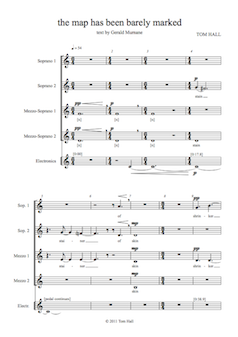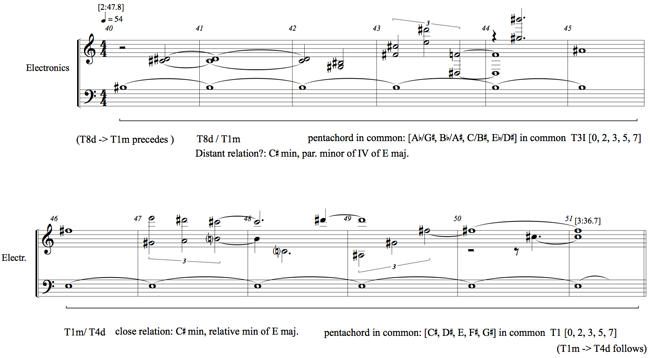the map has been barely marked
Dr Tom Hall, REF 2014, item 2
Audio
Score

REF Statement
the map has been barely marked for women’s voices (S, S, M-S, M-S) and stereo fixed electronics. Commissioned and performed by Scottish Voices, Glasgow University Chapel, as part of the opening concert for the Conference on Interdisciplinary Musicology 30 August – 3 September 2011.
the map has been barely marked brings together a number of research imperatives and constraints, including:
- commissioning and setting a new text from Australian Nominee for the Nobel Prize for Literature, Gerald Murnane;
- combining womens’ voices with fixed electronics requiring no ‘click track’ and no input from myself in performance;
- making a electronic part using only SuperCollider software for synthesis and sequencing (relating to my other research, e.g. REF item 1);
- Using “referential centricity” as a structural harmonic aspect of the composition (see harmonic analysis, below).
The majority of the text of the composition comes from Murnane (1988), and is supplemented by new text as mentioned above and detailed in the programme note (see below). The implied narrator’s purpose in these namings is elucidation and clarity, yet the names are also poetic. The approach to text setting has similar aims, in which names are sequenced and textured to bring out, for example, similarities and differences between name semantic meanings and phonetic content.
The fixed audio part was synthesised in SuperCollider software primarily using vowel modelling, comprising a drone which runs throughout the composition, and three electronic interludes, creating a clearly perceptible formal structure. The interludes are temporally isolated, allowing the conductor to adjust to discrepancies between the intended and actual tempo during the performance.
Reference
Murnane, G., 1988. Inland. Sydney: William Heinemann Australia.
Programme Note
the map has been barely marked takes its title and source text from Inland, a 1988 novel by Australian writer Gerald Murnane. At one point in this work, the implied narrator seeks to understand his environment through imagining and listing names for ten geological components of the native soil in Melbourne over which he walked as a child (p.67). The text then reads, “I used to walk across my native district murmuring these and other such names”. Since first reading these names, I have often wondered what the others might have been, and when approaching this piece for womens’ voices, I contacted the author, who generously replied with a list of a further five names. Below are the fifteen names in the order set in the composition, where asterisks indicate the newer names, and carriage returns indicate sectional divisions within the piece. The electronic part was synthesised using SuperCollider software.
Gerald Murnane text
stainer-of-skin; shrinker-from-light; tough-in-the-fire; sourer-of-tongues;
yielder-to-rains; cling-to-all; boulder-crumb; resister-of-unseen-streams;
spurner of sunlight*; remembrancer-of-green-leaves; least-of-leaves*; tufts-against-the-wind*;
hue-of-hues*; dew-hoarder*; mirror-of-nothing;
Harmonic Analysis
The figure below glosses the harmonic approach used in the map has been barely marked, and was shown as part of the conference paper Unaligning Diatonicism: Listening and Composing around Post-atonal Tonality, also presented at CIM2011 (2011–09–02).
Note that in the figure, d stands for the diatonic collection, and m for the melodic minor ascending collection. So T8d below = Ab diatonic collection.
